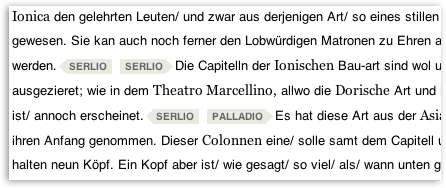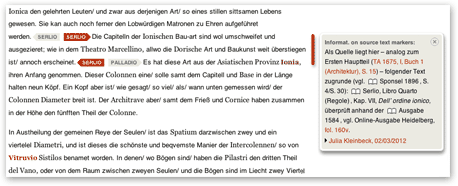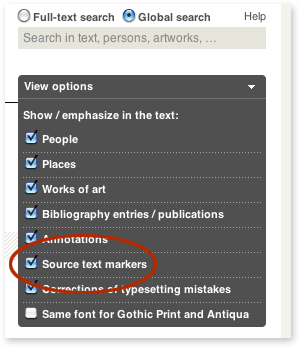Source text markers
Joachim von Sandrart’s “Teutsche Academie” was a result of profound studies of numerous source texts from the early modern period: In the theoretical chapter, the author draws upon writings by Giorgio Vasari, Carel van Mander, Sebastiano Serlio, Leonardo da Vinci and others, while in the antiquarian sections of the text, he refers to experts from the 16th and 17th century, such as Ulisse Aldrovandi or Alessandro Donati.
Furthermore, the vitae of antique and early modern Italian artists can be traced back to earlier publications by Giorgio Vasari, Carel van Mander, Carlo Ridolfi, Johann Neudörfer and others, while Cornelis de Bie’s Gulden Cabinet served as a template for the descriptions of cabinets of art. His translations, particularly of Dutch, French and Italian texts form a “besondere Art des Umgangs mit Bekanntem und Vertrautem, die sich von der produktiven Adaption von Texten der eigenen Sprache wenig bzw. eigentlich gar nicht unterschied” (cf. Laufhütte 2007, p. 231).
To separate Sandrart’s own information from those parts of the text where he compiles and adapts other sources, selected sections of the “Teutsche Academie” were reviewed. Jean Louis Sponsel’s very thorough index (1896) formed the basis for a comparison of the underlying source texts with Sandrart’s version. As a result of this work, “source text markers” have been added to Sandrart’s text in this edition. In addition to the authors’ names, which refer to the text being used in the section in question, each marker carries a short explanation of Sandrart’s approach. Wherever Sandrart deviates from the source – by additions, omissions, translations, by setting priorities differently etc. – a source text marker has been added, too.
The whole text of the “Teutsche Academie” was edited by poet Sigmund von Birken (cf. Klemm 1995; Laufhütte 1998, p. 25–29; Möseneder 2000, p. 163; Laufhütte 2011); therefore, trying to differentiate between Sandrart and Birken would be pointless. However, epigrams and the programmatical poems which Birken composed for numerous persons and the vignettes at the end of some chapters were marked.
To allow for effortless access of the source text referred to, links to digital editions of the texts were added, wherever possible. When no digital edition could be found, a modern scholarly edition was cited.


